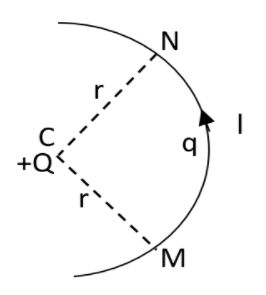
In the mentioned diagram, a charge $Q$ is fixed. Another charge $q$ is found to be moving along a circular arc $MN$ of radius $r$ around it, from the point $M$ to the point $N$ such that the length of the arc $MN=l$. Calculate the work done in this process?

$\begin{align}
& A.zero \\
& B.\dfrac{1}{4\pi {{\varepsilon }_{0}}}\dfrac{Qq}{{{r}^{2}}}l \\
& C.\dfrac{Qq}{2{{\varepsilon }_{0}}{{r}^{2}}}l \\
& D.\dfrac{Qq}{2\pi {{\varepsilon }_{0}}{{r}^{2}}} \\
\end{align}$

Answer
558.9k+ views
Hint: First of all let us analyse the diagram. As we can see that the point $M$ and $N$ are at identical distances from point $Q$. Therefore these will be having identical potential. The potential of a point can be found by taking the product of the ratio of one to the $4\pi {{\varepsilon }_{0}}$ and the ratio of the charge at this point to the square of the distance between them. The work done at this point can be found by taking the product of the potential at the point to the charge at the point. This will help you in answering this question.
Complete answer:
First of all let us analyse the diagram. As we can see that the point $M$ and $N$ are at identical distances from point $Q$. Therefore these will be having identical potential.
The potential of a point can be found by taking the product of the ratio of one to the $4\pi {{\varepsilon }_{0}}$ and the ratio of the charge at this point to the square of the distance between them. As the potentials are equal, we can write that,
${{V}_{M}}={{V}_{N}}=\dfrac{1}{4\pi {{\varepsilon }_{0}}}\dfrac{q}{r}$
As they are equal their difference will be equivalent to zero. That is,
${{V}_{M}}-{{V}_{N}}=0$
The work done at this point can be found by taking the product of the potential at the point to the charge at the point. This can be written as,
$W=\left( {{V}_{M}}-{{V}_{N}} \right)q$
Substituting the values in the equation will give,
$W=\left( {{V}_{M}}-{{V}_{N}} \right)q=0\times q=0$
Therefore the correct answer has been obtained as option A.
Note:
An electric potential is also known as the electric field potential or electrostatic potential. It is defined as the amount of work required to move a unit of electric charge from a reference position to a particular location in an electric field without creating an acceleration. Generally the reference point has been taken as the earth or infinity.
Complete answer:
First of all let us analyse the diagram. As we can see that the point $M$ and $N$ are at identical distances from point $Q$. Therefore these will be having identical potential.
The potential of a point can be found by taking the product of the ratio of one to the $4\pi {{\varepsilon }_{0}}$ and the ratio of the charge at this point to the square of the distance between them. As the potentials are equal, we can write that,
${{V}_{M}}={{V}_{N}}=\dfrac{1}{4\pi {{\varepsilon }_{0}}}\dfrac{q}{r}$
As they are equal their difference will be equivalent to zero. That is,
${{V}_{M}}-{{V}_{N}}=0$
The work done at this point can be found by taking the product of the potential at the point to the charge at the point. This can be written as,
$W=\left( {{V}_{M}}-{{V}_{N}} \right)q$
Substituting the values in the equation will give,
$W=\left( {{V}_{M}}-{{V}_{N}} \right)q=0\times q=0$
Therefore the correct answer has been obtained as option A.
Note:
An electric potential is also known as the electric field potential or electrostatic potential. It is defined as the amount of work required to move a unit of electric charge from a reference position to a particular location in an electric field without creating an acceleration. Generally the reference point has been taken as the earth or infinity.
Recently Updated Pages
A man running at a speed 5 ms is viewed in the side class 12 physics CBSE

The number of solutions in x in 02pi for which sqrt class 12 maths CBSE

State and explain Hardy Weinbergs Principle class 12 biology CBSE

Write any two methods of preparation of phenol Give class 12 chemistry CBSE

Which of the following statements is wrong a Amnion class 12 biology CBSE

Differentiate between action potential and resting class 12 biology CBSE

Trending doubts
What are the major means of transport Explain each class 12 social science CBSE

Which are the Top 10 Largest Countries of the World?

Draw a labelled sketch of the human eye class 12 physics CBSE

How much time does it take to bleed after eating p class 12 biology CBSE

Explain sex determination in humans with line diag class 12 biology CBSE

When was the first election held in India a 194748 class 12 sst CBSE




